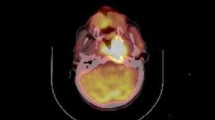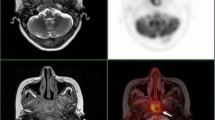Abstract
Purpose
To conduct a head-to-head comparison of the diagnostic ability of 68Ga-DOTA-FAPI-04 (68Ga-FAPI) and 18F-FDG PET/MR in nasopharyngeal carcinoma (NPC) patients.
Methods
Patients diagnosed with NPC were prospectively enrolled. All patients underwent head-and-neck 68Ga-FAPI PET/MR and 18F-FDG PET/MR within 1 week. Primary tumor, lymph node numbers, and tracer uptake were compared by SUVmax and visual evaluation. The primary tumor volumes derived from 68Ga-FAPI, 18F-FDG PET, and MRI were also compared.
Results
Fifteen patients were enrolled from June to August 2020. Both 68Ga-FAPI and 18F-FDG PET had 100% detection rate of the primary tumor. The 68Ga-FAPI SUVmax of primary tumors (13.87 ± 5.13) was lower than that of 18F-FDG (17.73 ± 6.84), but the difference was not significant (p = 0.078). Compared with 18F-FDG, 68Ga-FAPI PET improved the delineation of skull-base invasion in eight out of eight patients and intracranial invasion in four out of four patients. When 25%SUVmax of 68Ga-FAPI or 20%SUVmax of 18F-FDG was utilized as a threshold for determining tumor volume, it was highly consistent with MRI. 18F-FDG PET detected much more positive lymph nodes than 68Ga-FAPI (100 vs 48). The SUVmax of 48 paired lymph nodes was significantly lower on 68Ga-FAPI than 18F-FDG (8.67 ± 3.88 vs 11.79 ± 6.17, p < 0.001). Additionally, 68Ga-FAPI further detected four highly suspected small, distant metastases in three patients. Compared with 18F-FDG, 68Ga-FAPI changed overall staging in six of fifteen patients, with three patients being up-staged, and three down-staged.
Conclusion
68Ga-FAPI outperforms 18F-FDG in delineating the primary tumor and detecting suspected distant metastases, particularly in the evaluation of skull-base and intracranial invasion, suggesting 68Ga-FAPI hybrid PET/MR has the potential to serve as a single-step staging modality for patients with NPC. However, its value regarding lymph node and distant metastases evaluation needs further study.
Trial registration
NCT04554719. Registered September 8, 2020 - retrospectively registered, http://clinicaltrails.gov/show/NCT04554719






Similar content being viewed by others
Data availability
Not applicable.
Code availability
Not applicable.
References
Chen YP, Chan ATC, Le QT, Blanchard P, Sun Y, Ma J. Nasopharyngeal carcinoma. Lancet. 2019;394:64–80. https://doi.org/10.1016/S0140-6736(19)30956-0.
Lai V, Khong PL. Updates on MR imaging and 18F-FDG PET/CT imaging in nasopharyngeal carcinoma. Oral Oncol. 2014;50:539–48. https://doi.org/10.1016/j.oraloncology.2013.05.005.
Colevas AD, Yom SS, Pfister DG, Spencer S, Adelstein D, Adkins D, et al. NCCN guidelines insights: head and neck cancers, version 1.2018. J Natl Compr Cancer Netw. 2018;16:479–90. https://doi.org/10.6004/jnccn.2018.0026.
Boellaard R, Delgado-Bolton R, Oyen WJ, Giammarile F, Tatsch K, Eschner W, et al. FDG PET/CT: EANM procedure guidelines for tumour imaging: version 2.0. Eur J Nucl Med Mol Imaging. 2015;42:328–54. https://doi.org/10.1007/s00259-014-2961-x.
Castaldi P, Leccisotti L, Bussu F, Miccichè F, Rufini V. Role of (18)F-FDG PET-CT in head and neck squamous cell carcinoma. Acta Otorhinolaryngol Ital. 2013;33:1–8.
Ng SH, Chan SC, Yen TC, Chang JT, Liao CT, Ko SF, et al. Staging of untreated nasopharyngeal carcinoma with PET/CT: comparison with conventional imaging work-up. Eur J Nucl Med Mol Imaging. 2009;36:12–22. https://doi.org/10.1007/s00259-008-0918-7.
Cheng Y, Bai L, Shang J, Tang Y, Ling X, Guo B, et al. Preliminary clinical results for PET/MR compared with PET/CT in patients with nasopharyngeal carcinoma. Oncol Rep. 2020;43:177–87. https://doi.org/10.3892/or.2019.7392.
Chan SC, Yeh CH, Yen TC, Ng SH, Chang JT, Lin CY, et al. Clinical utility of simultaneous whole-body (18)F-FDG PET/MRI as a single-step imaging modality in the staging of primary nasopharyngeal carcinoma. Eur J Nucl Med Mol Imaging. 2018;45:1297–308. https://doi.org/10.1007/s00259-018-3986-3.
Cao C, Yang P, Xu Y, Niu T, Hu Q, Chen X. Feasibility of multiparametric imaging with PET/MR in nasopharyngeal carcinoma: a pilot study. Oral Oncol. 2019;93:91–5. https://doi.org/10.1016/j.oraloncology.2019.04.021.
Kratochwil C, Flechsig P, Lindner T, Abderrahim L, Altmann A, Mier W, et al. (68)Ga-FAPI PET/CT: tracer uptake in 28 different kinds of cancer. J Nucl Med. 2019;60:801–5. https://doi.org/10.2967/jnumed.119.227967.
Loktev A, Lindner T, Mier W, Debus J, Altmann A, Jäger D, et al. A tumor-imaging method targeting cancer-associated fibroblasts. J Nucl Med. 2018;59:1423–9. https://doi.org/10.2967/jnumed.118.210435.
Giesel FL, Kratochwil C, Lindner T, Marschalek MM, Loktev A, Lehnert W, et al. (68)Ga-FAPI PET/CT: biodistribution and preliminary dosimetry estimate of 2 DOTA-containing FAP-targeting agents in patients with various cancers. J Nucl Med. 2019;60:386–92. https://doi.org/10.2967/jnumed.118.215913.
Syed M, Flechsig P, Liermann J, Windisch P, Staudinger F, Akbaba S, et al. Fibroblast activation protein inhibitor (FAPI) PET for diagnostics and advanced targeted radiotherapy in head and neck cancers. Eur J Nucl Med Mol Imaging. 2020. https://doi.org/10.1007/s00259-020-04859-y.
Wu HB, Wang QS, Wang MF, Zhen X, Zhou WL, Li HS. Preliminary study of 11C-choline PET/CT for T staging of locally advanced nasopharyngeal carcinoma: comparison with 18F-FDG PET/CT. J Nucl Med. 2011;52:341–6. https://doi.org/10.2967/jnumed.110.081190.
Co J, Mejia MB, Dizon JM. Evidence on effectiveness of intensity-modulated radiotherapy versus 2-dimensional radiotherapy in the treatment of nasopharyngeal carcinoma: meta-analysis and a systematic review of the literature. Head Neck. 2016;38(Suppl 1):E2130–42. https://doi.org/10.1002/hed.23977.
Ng SH, Joseph CT, Chan SC, Ko SF, Wang HM, Liao CT, et al. Clinical usefulness of 18F-FDG PET in nasopharyngeal carcinoma patients with questionable MRI findings for recurrence. J Nucl Med. 2004;45:1669–76.
Ng SH, Chang JT, Chan SC, Ko SF, Wang HM, Liao CT, et al. Nodal metastases of nasopharyngeal carcinoma: patterns of disease on MRI and FDG PET. Eur J Nucl Med Mol Imaging. 2004;31:1073–80. https://doi.org/10.1007/s00259-004-1498-9.
Shen G, Xiao W, Han F, Fan W, Lin XP, Lu L, et al. Advantage of PET/CT in target delineation of MRI-negative cervical lymph nodes in intensity-modulated radiation therapy planning for nasopharyngeal carcinoma. J Cancer. 2017;8:4117–23. https://doi.org/10.7150/jca.21582.
Peng H, Chen L, Tang LL, Li WF, Mao YP, Guo R, et al. Significant value of (18)F-FDG-PET/CT in diagnosing small cervical lymph node metastases in patients with nasopharyngeal carcinoma treated with intensity-modulated radiotherapy. Chin J Cancer. 2017;36:95. https://doi.org/10.1186/s40880-017-0265-9.
Lee SH, Huh SH, Jin SM, Rho YS, Yoon DY, Park CH. Diagnostic value of only 18F-fluorodeocyglucose positron emission tomography/computed tomography-positive lymph nodes in head and neck squamous cell carcinoma. Otolaryngol Head Neck Surg. 2012;147:692–8. https://doi.org/10.1177/0194599812443040.
Tsai MC, Shu YC, Hsu CC, Lin CK, Lee JC, Chu YH, et al. False-positive finding of retropharyngeal lymph node recurrence in both fluorine (18)FDG PET and MRI in a patient with nasopharyngeal carcinoma. Head Neck. 2016;38:E84–6. https://doi.org/10.1002/hed.24205.
Shen G, Zhang W, Jia Z, Li J, Wang Q, Deng H. Meta-analysis of diagnostic value of 18F-FDG PET or PET/CT for detecting lymph node and distant metastases in patients with nasopharyngeal carcinoma. Br J Radiol. 2014;87:20140296. https://doi.org/10.1259/bjr.20140296.
Dohi O, Ohtani H, Hatori M, Sato E, Hosaka M, Nagura H, et al. Histogenesis-specific expression of fibroblast activation protein and dipeptidylpeptidase-IV in human bone and soft tissue tumours. Histopathology. 2009;55:432–40. https://doi.org/10.1111/j.1365-2559.2009.03399.x.
Pang Y, Zhao L, Chen H. 68Ga-FAPI outperforms 18F-FDG PET/CT in identifying bone metastasis and peritoneal carcinomatosis in a patient with metastatic breast cancer. Clin Nucl Med. 2020;45:913–5. https://doi.org/10.1097/rlu.0000000000003263.
Pang Y, Zhao L, Luo Z, Hao B, Wu H, Lin Q, et al. Comparison of (68)Ga-FAPI and (18)F-FDG uptake in gastric, duodenal, and colorectal cancers. Radiology. 2020:203275. https://doi.org/10.1148/radiol.2020203275.
Funding
This work was supported in part by the Key Project of National Natural Science Foundation of China (No. 81630049, 82030052), and National Key R&D Program of China (No. 2019 YFC 1316204).
Author information
Authors and Affiliations
Corresponding authors
Ethics declarations
Ethics approval
This article does not contain any experiments with animals. All procedures involving human participants were carried out in accordance with the ethical standards of the institutional and/or national research committee and with the 1964 Helsinki Declaration and its later amendments or comparable ethical standards. This study was approved by the Clinical Research Ethics Committee of Union Hospital, Tongji Medical College, Huazhong University of Science and Technology (NO. 20200290).
Consent to participate
Informed consent was obtained from all individual participants included in this study.
Consent for publication
Informed consent was obtained from all individual participants included in this study.
Conflict of interest
The authors declare no competing interests.
Additional information
Publisher’s note
Springer Nature remains neutral with regard to jurisdictional claims in published maps and institutional affiliations.
This article is part of the Topical Collection on Oncology - Head and Neck
Rights and permissions
About this article
Cite this article
Qin, C., Liu, F., Huang, J. et al. A head-to-head comparison of 68Ga-DOTA-FAPI-04 and 18F-FDG PET/MR in patients with nasopharyngeal carcinoma: a prospective study. Eur J Nucl Med Mol Imaging 48, 3228–3237 (2021). https://doi.org/10.1007/s00259-021-05255-w
Received:
Accepted:
Published:
Issue Date:
DOI: https://doi.org/10.1007/s00259-021-05255-w




